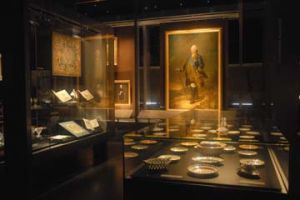 |

|
 Freemasonry museum © T. Joly Freemasonry museum © T. Joly

|
French freemasonry would like to be better known by the general public. Its recently renovated museum recalls the order’s history and provides a glimpse of its practices and rituals through a collection of more than three hundred artifacts.
[ Practical ]
Musée de la Franc-maçonnerie
Grand Orient de France
16 rue Cadet, 75009 Paris
Opening dates and hours
Open Tuesday to Friday and Sunday from 10am to 12.30pm and from 2 pm to 6 pm, Saturday from 10am to 1pm and from 2pm to 7pm.
Closed on Bank holidays.
Admission
Museum : €6 / €4.
Museum and temple guided tours every Saturday at 2.30pm and 3.30pm. Price : €7 + admission fee to the museum).
Information
Tel : 0145237409
www.museefm.org
The Grand Orient de France is the foremost and oldest obedience of French freemasonry and boasts a rich museum within the walls of its Parisian headquarters. The institution has a long history. Founded in 1889, it was closed at the beginning of the Second World War and only reopened in 1973. Then, in 2000, it was labelled as a “Musée de France” when it shifted its focus from the Grand Orient de France and began providing information about freemasonry as a whole.
 Desire for openness and transparency Desire for openness and transparency
Ever since, almost every obedience has been represented in its Scientific Committee and in the Museum Friends Association. Over the years, however, the premises and its layout became old-fashioned, outdated and in need of a facelift. After almost two years of extensive renovations, the work is now complete. Many of the collections have also been augmented with new acquisitions and loans from private sources.
Now, utilising modern scenography, the museum is designed to be a symbol of the freemason’s desire for openness and transparency as well to disprove the myth that the order has something to hide, a charge frequently laid against it. The museum consists of a single 800m² room with a ceiling depicting a starry sky and walls resembling those of a grotto. The décor places Man firmly at the centre of the universe. It holds more than 300 artefacts that belonged to freemasons or were used during lodge ceremonies as well as historical documents.
 Voltaire’s apron Voltaire’s apron
Visitors can discover seals, jewels, medals, paintings, engravings, prints, emblems, banners, manuscripts, aprons of different degrees and of course freemasons’ two symbolic tools, the square and the compass. In addition, some of the objects on display are exceptional or extremely rare. A 1723 original edition of Anderson’s Constitution, the sword of Venerable La Fayette, aprons that belonged to Voltaire and Jerome Bonaparte, ephemeral King of Westphalia, the largest collection of 18th century Masonic porcelain painted with the emblems and symbols of the different degrees of the order.
This collection is presented in about fifteen horizontal and vertical windows mainly tracing back the freemasonry history and highlighting its political, economic and social role in French society over the last three centuries.
 Three centuries of history Three centuries of history
Firstly, its beginnings, the spreading of its ideas during the Siècle des Lumières and its Golden Age under the Empire are showcased. Then a large area is dedicated to the difficulties encountered by freemasonry during the 19th century. Close to the Republican movement, it had to confront the suspicions of the last Kings of France and Napoleon III. Moreover, the ever-changing society of the time forced the freemasons to make some rapid adaptations. Lastly, the visit ends with a depiction of the order’s contribution to social progress in France in the 20th century. The section on the Second World War tells of the persecution and plunder freemasonry suffered when the Vichy government outlawed it even before imposing its anti-Jewish laws.
In parallel, a large board illustrated with portraits gives an account of its foremost great masters and its most illustrious members in chronological order.
 Temple visit Temple visit
Here one learns that Jules Ferry, the politician who created free, compulsory, secular school in France, was a freemason, as was Leon Bourgeois, the 1920 Nobel Peace prize-winner, one of the men behind the League of Nations, the precursor to the UN. Clear and concise, this historical reminder is of great interest and provides a wealth of lesser-known facts.
Elsewhere, a number of windows have been devoted to how masonic lodges work. This time, the theme is not as developed as the previous one. The Freemasons’ initiation rites, duties, grades, symbols and rituals are described in a superficial, light manner that may provoke more questions than answers among visitors. Perhaps this topic will be given more colour in future temporary exhibitions. A 400 m² room has been built for this purpose and the Grand Orient de France still has another collection of almost 10,000 items. In the meantime, to learn more about freemasons and lodge life, why not join one of the guided tours through the twenty temples housed in the headquarters.
January 23, 2013
Thierry Joly 

|



